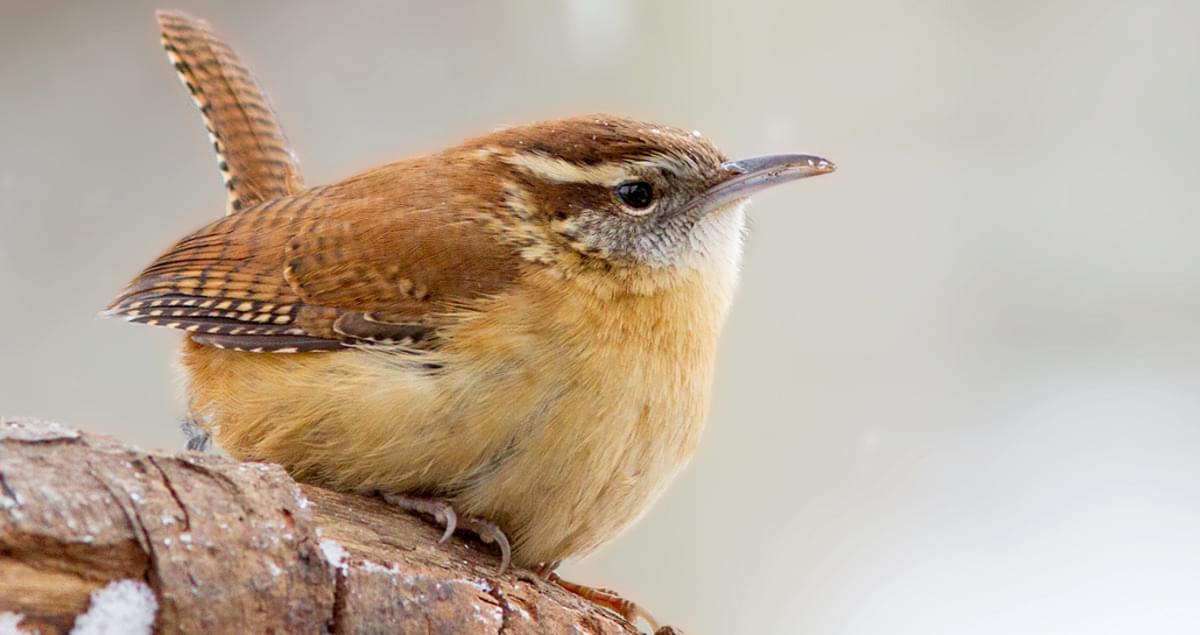In North America, there have been observations of 11 different wren species, and Arkansas has been a habitat for 7 of these species. All wren species found in Arkansas are considered to be regularly present.
Throughout the year, Carolina Wrens and Bewick’s Wrens can be seen in Arkansas.
During the winter months, Winter Wrens and Rock Wrens can be found in Arkansas.
When it comes to migration, House Wrens, Sedge Wrens, and Marsh Wrens can be spotted in Arkansas.
Wrens are ordinary-looking songbirds with distinctive traits and vibrant personalities. They are relatively small, plump, brown birds with upright tails and powerful voices.
Wrens are categorized as New World birds, inhabiting North and South America. However, the Eurasian Wren, which is part of the Old World, can be found in Europe and Africa. Wrens belong to the Troglodyidae bird family.
Insects and spiders make up the majority of wrens’ diet. This allows them to survive in various environments, including dry and rocky areas with sparse vegetation.
Previously, it was believed that Winter Wrens were the same species as Pacific Wrens and Eurasian Wrens. However, they have now been recognized as three distinct species.
Throughout history, wrens have been associated with folklore and symbolism. In Europe, it was once believed that harming wrens would bring misfortune.
This guide aims to assist you in identifying wren species in Arkansas, using information from avibase. The list of wrens provided is arranged based on their frequency of sightings, as reported by birdwatchers in Arkansas through ebird checklists.
To help you identify the birds that visit your backyard, you can obtain a free bird identification photo guide specific to Arkansas.
Arkansas is home to the following 7 species of wrens:
1. Carolina Wren
2. House Wren
3. Winter Wren
4. Sedge Wren
5. Marsh Wren
6. Bewick’s Wren
7. Rock Wren
Let’s take a closer look at some of these wren species:
Carolina Wren
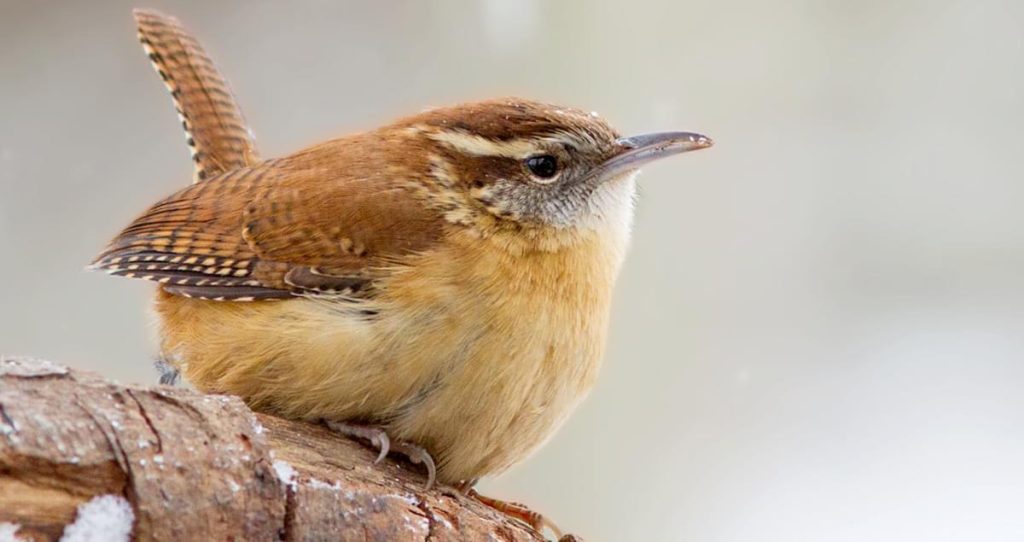
Carolina Wrens are the most commonly observed wrens in Arkansas and do not migrate. They are present in 42% of summer checklists and 38% of winter checklists submitted by birdwatchers.
Carolina Wrens are shy birds with a dark brown upper body and a lighter brown underside. They have an upright tail and a white stripe above the eye.
Thryothorus ludovicianus
Length: 4.7-5.5 in (12-14 cm)
Weight: 0.6-0.8 oz (18-22 g)
Wingspan: 11.4 in (29 cm)
Carolina Wrens can be found year-round in Eastern and Southeastern states.
These wrens inhabit wooded areas and dense vegetation. They also visit backyard feeders and primarily feed on insects and spiders. Occasionally, they may consume lizards, frogs, and snakes.
Carolina Wrens produce a short song consisting of quick whistles.
Bobby Wilcox, XC616879. Accessible at www.xeno-canto.org/616879.
The nests of Carolina Wrens are typically found in trees, but they can build nests in various locations. The nests are nearly circular with a small opening on the side. They lay 3-7 eggs, which take approximately two weeks to hatch. The chicks require an additional two weeks to fledge.
To attract Carolina Wrens to your backyard, provide suet feeders, hulled sunflower seeds, or peanut hearts in large tube feeders or platform feeders.
Interesting fact: Carolina Wrens form lifelong pair bonds.
House Wren
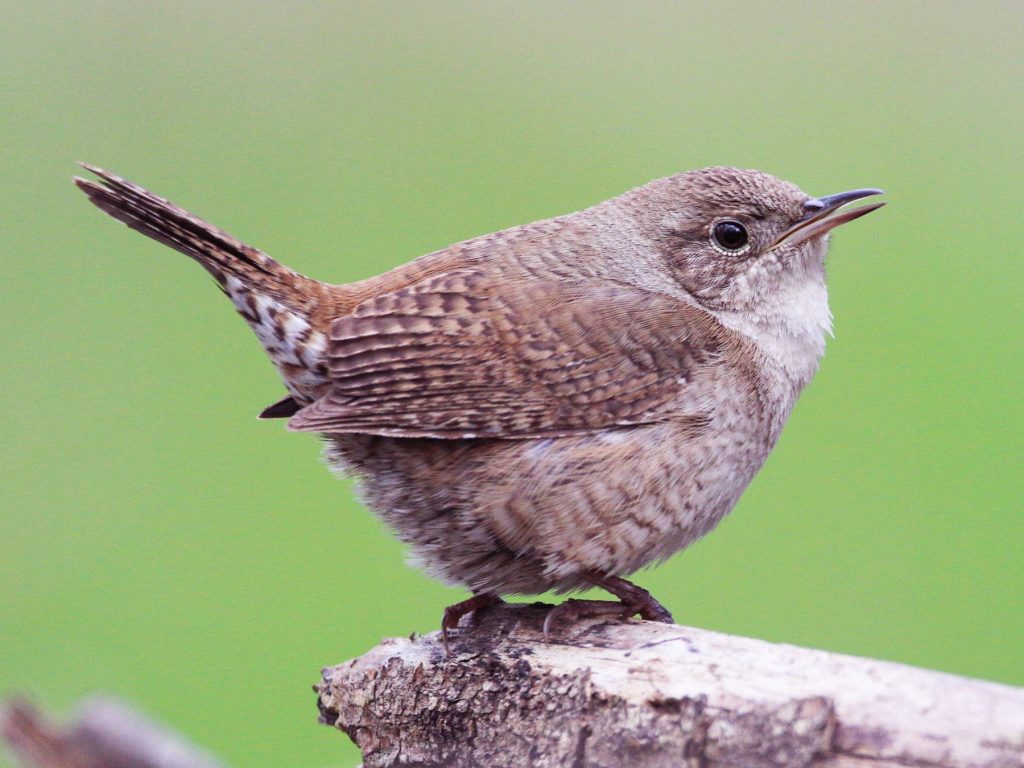
While some House Wrens can be seen year-round in Arkansas, they are more commonly observed during fall migration in October, appearing in 5.7% of checklists during this period.
House Wrens are small, nondescript birds with round brown bodies. They have darker wings and tails with barred patterns and a paler throat. Male and female House Wrens share the same appearance.
Distinguishing feature: The eyestripe is less noticeable compared to other wren species.
Troglodytes aedon
Length: 4.3-5.1 in (11-13 cm)
Weight: 0.3-0.4 oz (10-12 g)
Wingspan: 5.9 in (15 cm)
During summer, House Wrens breed in the US and Southern Canada. In winter, they migrate to the South and Mexico.
House Wrens can be found in backyards, parks, and open woods, where they search for insects and spiders. They are known for their energetic hopping and singing.
Their diet consists of insects, such as beetles, caterpillars, and flies, as well as snail shells for calcium.
House Wrens produce a series of jumbled notes that vary in pitch and speed.
Peter Boesman, XC693927. Accessible at www.xeno-canto.org/693927.
The nests of House Wrens are typically located in old woodpecker holes, nest boxes, or other small crevices. They prefer lightly wooded areas and construct nests using twigs, lining them with softer materials. House Wrens lay 3-10 eggs, and hatching takes around two weeks, with an additional two weeks for fledging.
To attract House Wrens to your backyard, leave piles of brush or install nest boxes.
Interesting fact: Despite their small size, House Wrens can be fierce when competing for nest holes, often displacing larger birds and even removing eggs or nestlings.
Winter Wren
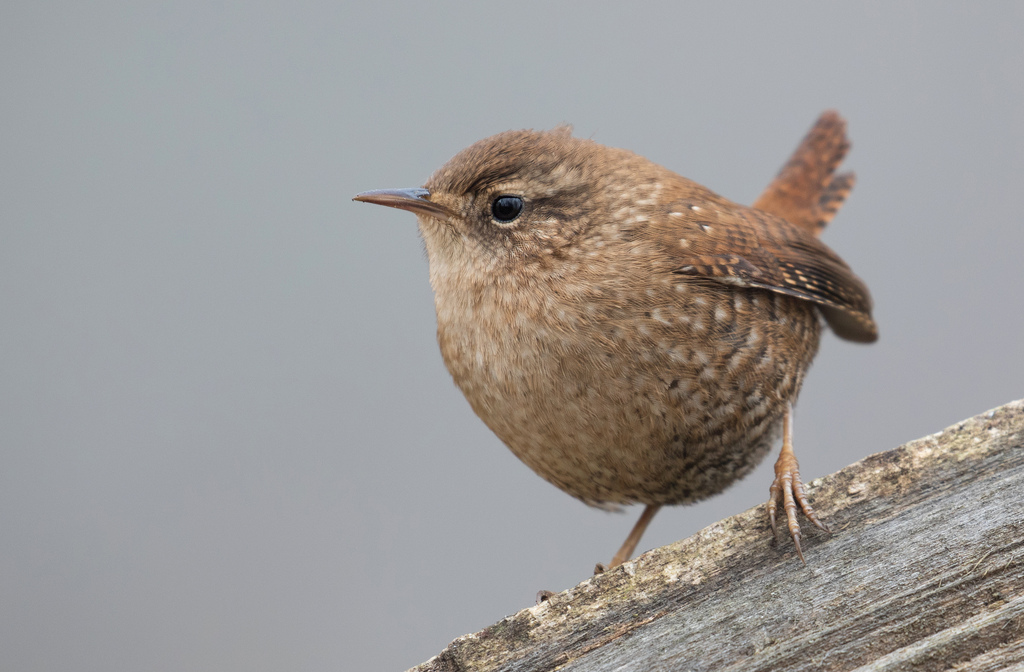
Winter Wrens can be found in Arkansas during winter and are present in 4% of checklists. They begin arriving as early as August and may stay until June, with the best months for observation being October to March.
Winter Wrens are small and plump with brown feathers. They have darker barring on their wings, tail, and belly. These wrens possess a paler eyebrow stripe and short, upright tails. Male and female Winter Wrens have similar appearances.
Winter Wrens closely resemble Pacific Wrens, and they were previously considered the same species. However, they are now classified as distinct species with different songs.
Troglodytes hiemalis
Length: 3.1-4.7 in (8-12 cm)
Weight: 0.3-0.4 oz (8-12 g)
Wingspan: 4.7-6.3 in (12-16 cm)
Winter Wrens can be found in eastern US states during winter and in northeastern US states and Canada during summer.
These wrens can be spotted hiding in tangled undergrowth within forests and backyards. Their diet primarily consists of insects and spiders, which they forage by rummaging through fallen leaves and decaying bark.
Winter Wrens produce a long, bubbly, sweet song that lasts up to 10 seconds.
David Welch, XC575300. Accessible at www.xeno-canto.org/575300.
Nests of Winter Wrens are constructed using twigs, moss, and grass woven together in a rounded shape with a small opening. They lay 1-9 eggs, with hatching taking approximately two weeks. Fledging occurs after the same duration.
To attract Winter Wrens to your backyard, provide native plants and maintain dense vegetation.
Interesting fact: Winter Wren nests are rounded with a small opening and can sometimes hang from trees.
Sedge Wren
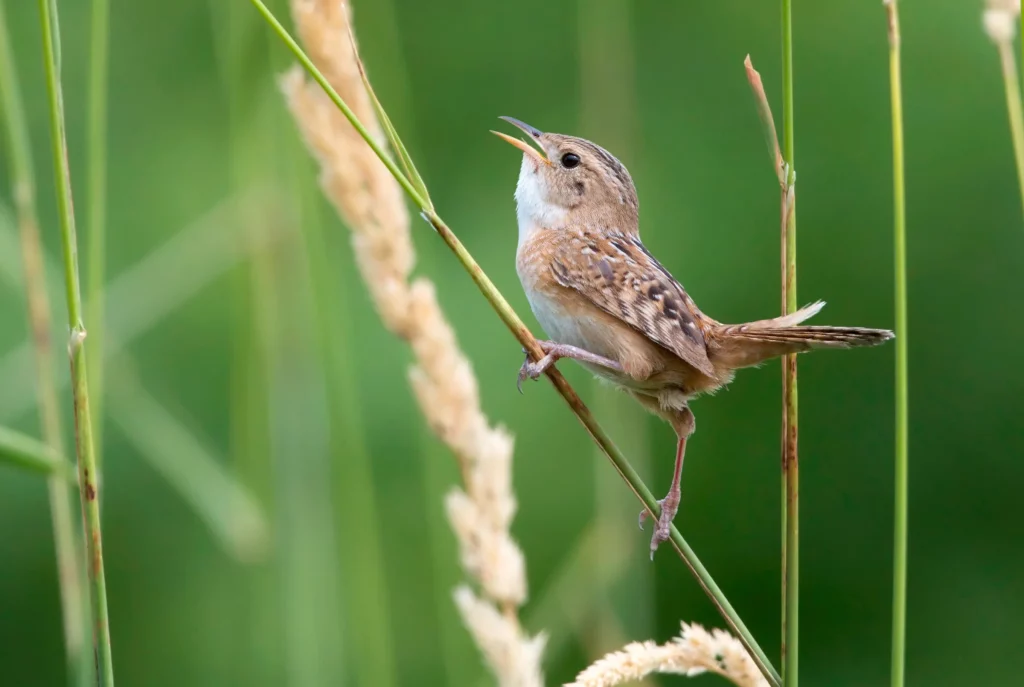
Sedge Wrens can be observed in Arkansas during spring and fall migration, with some individuals remaining until winter in the southern part of the state. October is the optimal month for spotting them, and they are recorded in 3.5% of checklists during this period.
Sedge Wrens are small brown wrens with darker upper bodies featuring streaks and barring. Their undersides are paler, and they possess a light eyebrow stripe. Male and female Sedge Wrens have a similar appearance.
Sedge Wrens bear a resemblance to Marsh Wrens and can be found in similar wet habitats. However, Marsh Wrens lack striped shoulders and have lighter bellies.
Cistothorus stellaris
Length: 3.9-4.7 in (10-12 cm)
Weight: 0.3-0.3 oz (7-10 g)
Wingspan: 4.7-5.5 in (12-14 cm)
Sedge Wrens breed in southern Canada, the Midwest, and sometimes further east in the US. They migrate and spend winter in southeastern states and northern Mexico, primarily near the Gulf and Atlantic coasts.
These wrens are typically well-hidden within wet grasslands, marshy areas, and meadows with abundant vegetation. They prefer shallower habitats compared to Marsh Wrens and feed on insects and spiders.
Sedge Wrens produce a simple song consisting of a few short notes followed by more rapid notes of similar pitch.
Paul Driver, XC659291. Accessible at www.xeno-canto.org/659291.
Interesting fact: Sedge Wrens are not known for their pleasant nature. If another Sedge Wren nests too close, they may pierce the eggs of their neighboring wrens, destroying them.
Marsh Wren
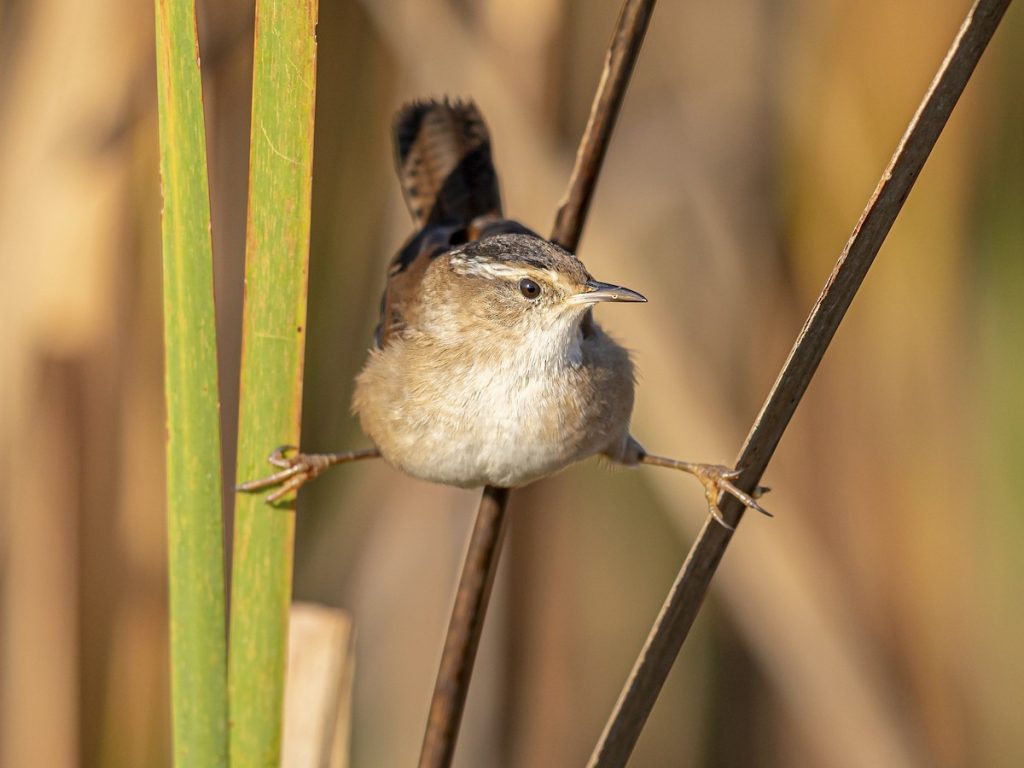
Marsh Wrens can be observed during spring and fall migration in Arkansas, with their highest abundance occurring in October. They are recorded in 3.6% of checklists during this period.
Marsh Wrens have brown bodies with black and white streaks on their backs. Their undersides are grayish brown, and they possess the characteristic upright tail seen in wrens. Unlike Sedge Wrens, Marsh Wrens lack shoulder stripes and have longer bills. Male and female Marsh Wrens share the same plumage.
Cistothorus palustris
Length: 3.9-5.5 in (10-14 cm)
Weight: 0.3-0.5 oz (9-14 g)
Wingspan: 5.9 in (15 cm)
Marsh Wrens breed in northern US states and central Canada before migrating to southern states and Mexico. Some individuals in the western and Atlantic coastal regions may remain resident throughout the year. During migration, they can be found in the eastern US.
Marsh Wrens are typically found in wetland areas, clinging to reeds with each foot grasping a different stalk. Although they can be challenging to spot, their songs can be heard among the reeds, especially during dawn and dusk. They feed on insects and spiders, picking them off leaves close to the water.
Marsh Wrens produce a distinctive buzzy song that can last up to 20 minutes.
Jarrod Swackhamer, XC591813. Accessible at www.xeno-canto.org/591813.
Marsh Wrens build fully enclosed nests with a small opening at the top. Their nests are constructed from reeds and grasses woven together. They lay 3-10 eggs, with hatching taking around two weeks and fledging occurring after an additional two weeks.
Interesting facts: Marsh Wrens may create up to twenty dummy nests attached to cattails, but they
usually utilize only one nest. They may destroy the eggs and nestlings of competing birds.
Bewick’s Wren
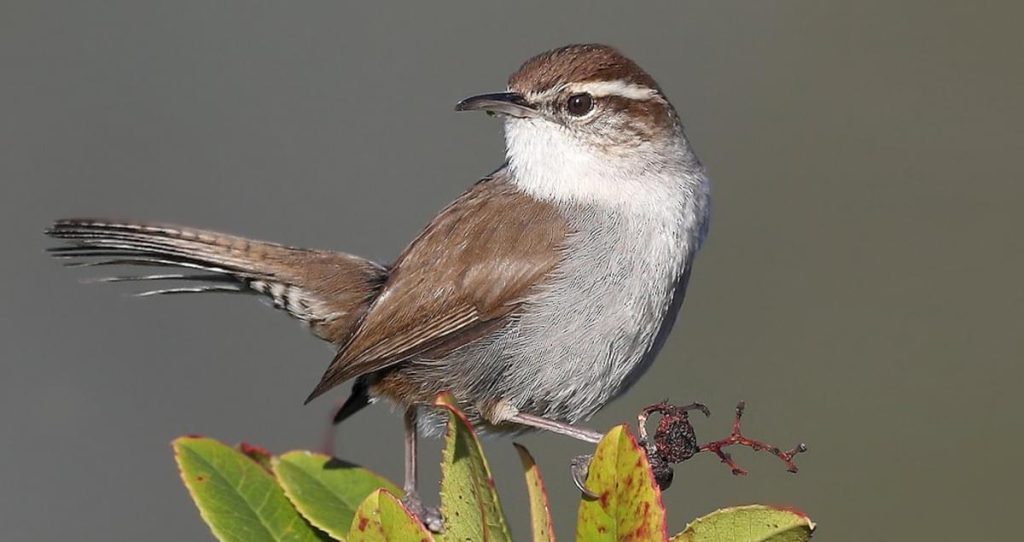
Bewick’s Wrens are not very common in Arkansas, but they are considered regularly present in the state and have been observed throughout the year, primarily in the western region.
Bewick’s Wrens have brown backs with long, gray, upright tails featuring darker barring. Their bellies are gray, and they possess a white stripe above the eye.
Thryomanes bewickii
Length: 5.1 in (13 cm)
Weight: 0.3-0.4 oz (8-12 g)
Bewick’s Wrens can be found year-round in southern and western states, with occasional small movements during winter.
These wrens can be spotted in scrublands, thickets, and open woodlands, where they hop from branch to branch, flicking their long tails. They primarily feed on insects and larvae, including bees, bugs, caterpillars, and beetles.
Bewick’s Wrens produce a song starting with a couple of short higher notes, followed by lower-pitched buzzy notes.
Manuel Grosselet, XC687852. Accessible at www.xeno-canto.org/687852.
Bewick’s Wren nests are typically found on rock ledges, in old woodpecker nests, nest boxes, or crevices in buildings. The nests are cup-shaped and made of sticks and grasses with a softer lining. They lay 3-8 eggs, with hatching taking around two weeks and fledging occurring after an additional two weeks.
To attract Bewick’s Wrens to your backyard, provide suet, mealworms, and hulled sunflower seeds.
Interesting fact: House Wrens are believed to contribute to the decline of Bewick’s Wrens in the eastern US as they often destroy their eggs.
Rock Wren
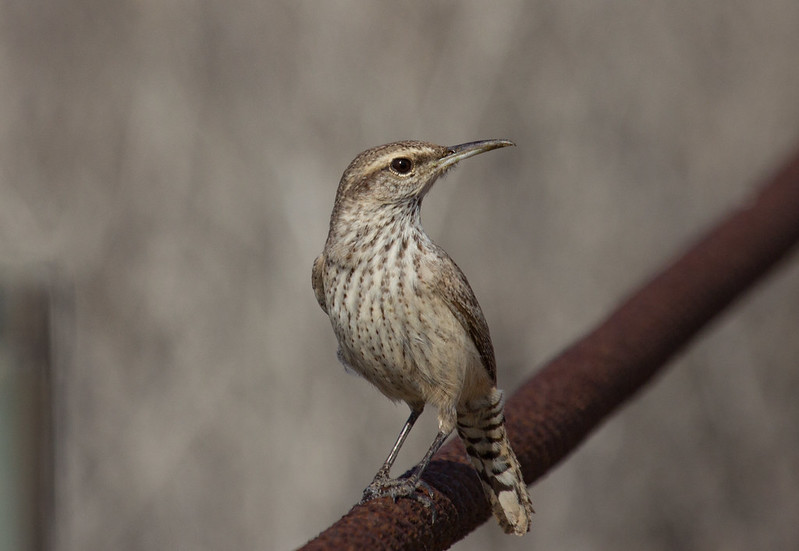
Rock Wrens are rarely observed in Arkansas, but they are recognized as regularly occurring during winter.
Rock Wrens have pale brown backs with darker flecks. They possess barring on their wings and tail and exhibit a pale underside with buff coloring on the lower flanks and belly.
Distinctive features: They have a pale eyebrow stripe, a long slightly curved bill, and dark legs. Male and female Rock Wrens share the same coloration. These wrens bob up and down, especially when agitated, which can aid in their identification.
Salpinctes obsoletus
Length: 4.9-5.9 in (12.5-15 cm)
Weight: 0.5-0.6 oz (15-18 g)
Wingspan: 8.7-9.4 in (22-24 cm)
Rock Wrens are found in dry and rocky areas in western US states and southwestern Canada. While some remain resident throughout the year in the south and west, those in central US states migrate south for winter.
Look for Rock Wrens in dry and rocky areas with limited vegetation. They feed on insects found in crevices among the rocks.
Rock Wrens produce songs that vary in pitch with each rendition, sometimes consisting of the same sound repeated several times before transitioning to a different sound.
Paul Marvin, XC576852. Accessible at www.xeno-canto.org/576852.
Rock Wren nests are located on the ground, often in cavities or depressions within rocky areas. They incorporate a layer of small stones followed by softer materials like wool and moss. They may lay up to 8 eggs and produce up to 3 broods per year.
Interesting fact: Rock Wrens construct walkways made of stones and other objects leading to their nests, although the purpose of these walkways remains unknown. Additionally, they do not consume water directly but obtain sufficient moisture from the insects they consume.
How to Attract Wrens to Your Backyard
Having wrens visit your backyard allows you to enjoy their beautiful songs and observe their energetic behavior up close. While only a few wren species regularly visit backyards, including House Wrens, Carolina Wrens, and Bewick’s Wrens, you can employ various strategies to attract them:
1. Embrace a less tidy approach: Provide habitats for insects and spiders, which are the favorite food of wrens. Leave fallen leaves and brush piles and preserve spider webs.
2. Provide clean water sources: Consider installing multiple locations with running water to attract wrens.
3. Create nesting sites: Wrens will utilize nest boxes or even old boots left out in the yard.
4. Offer suitable food: Wrens will consume mealworms, crickets, peanuts, and suet. Consider providing these food sources to attract them.
How Frequently Wrens are Spotted in Summer and Winter in Arkansas
Checklists serve as valuable resources to determine the common bird species observed in a specific area. The following lists indicate the frequency of wren sightings during summer and winter in Arkansas, based on ebird checklists:
Wrens in Arkansas in Summer:
– Carolina Wren: 42.1%
– House Wren: 2.5%
– Marsh Wren: 0.2%
– Sedge Wren: 0.2%
– Bewick’s Wren: 0.1%
– Winter Wren: <0.1%
– Rock Wren: <0.1%
Wrens in Arkansas in Winter:
– Carolina Wren: 38.7%
– Winter Wren: 4.1%
– House Wren: 1.1%
– Sedge Wren: 0.7%
– Marsh Wren: 0.4%
– Bewick’s Wren: 0.2%
– Rock Wren: 0.1%
